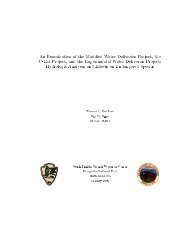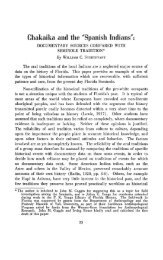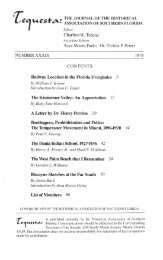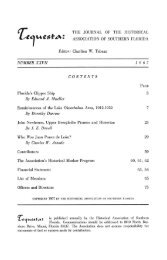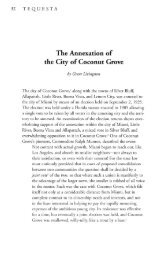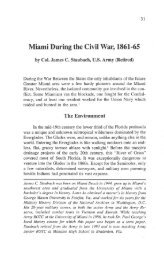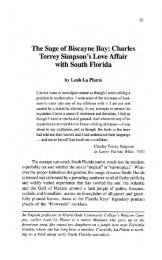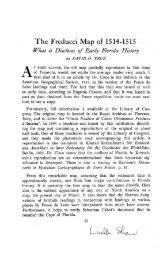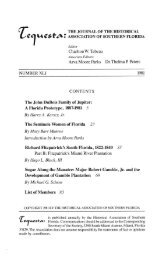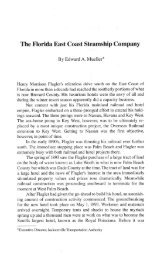Tequesta : Number - 50/1990 - FIU Digital Collections
Tequesta : Number - 50/1990 - FIU Digital Collections
Tequesta : Number - 50/1990 - FIU Digital Collections
Create successful ePaper yourself
Turn your PDF publications into a flip-book with our unique Google optimized e-Paper software.
20 TEQUESTA<br />
Living and developing a place in so unique a location among the<br />
Dade County pines was a fascinating experience, and I tried to share<br />
what I observed, learned, and thought with Miami Herald readers. It is<br />
through the preservation of those columns as well as from notes I kept<br />
that I am able to write this. The following is taken from a column:<br />
"Strolling through the woods in a leisurely way, I like to make myself<br />
aware of the physical and chemical elements at work and the roles they<br />
have played in the creation of this place, which only a few years ago was<br />
a small part of a wildemess covering much of the country. Each<br />
contributing element is a science in itself. First, there is the geology -<br />
the structure of the land, its elevation and history. There is the soil -<br />
the thin mantle over the limestone rock, created by the interplay of<br />
weathering, the decay of dead plants, and the physical and chemical<br />
activities of plant roots. There is the botany - the pines and the<br />
understory plants, including the underfoot things that grow and bloom<br />
without being seen unless you are particularly observant. There is the<br />
zoology - the microorganisms, insects, amphibians, reptiles, birds,<br />
and four-footed animals that live here. There is the weather, changing<br />
with the seasons, bringing sultry mornings and afternoon thundershowers<br />
in summer, sometimes tropical storms in August, September or<br />
October, then the usually dry, pleasantly cool days of late fall, winter,<br />
and early spring.<br />
"While my acquaintance with any of these sciences is superficial<br />
when compared with the knowledge of an expert, I have learned enough<br />
about them to appreciate their contribution to the landscape. And I also<br />
know enough about the ecology of the pine woods - the interrelationship<br />
of all the living things and nature's forces - to realize how easily<br />
the balance of nature is upset by mankind's best intentions as well as by<br />
his worst. But because of their subtlety and complexity, it is virtually<br />
impossible to observe the various forces actually playing their roles,<br />
even as you view the landscape every day with discerning eyes. At any<br />
moment of experience the human is too insensitive to see more than the<br />
flight of a bird, to hear the rasping of a cicada, or be aware of a falling<br />
leaf wrenched from a twig by a passing breeze. Perhaps it is enough for<br />
the non-scientist to know that the interplay of nature's forces is taking<br />
place, and has been taking place for thousands of years in order to create<br />
a pine forest, together with the adaptation of the countless living things,<br />
both plants and animals, associated with it."<br />
On another occasion I wrote that "sometimes as I walk through the<br />
pine woods, or while sitting idly on the breezeway late in the day,



